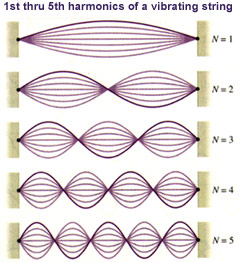Music is such a wonderful pursuit for mind and body because it is not just an art form, but combines a myriad of other disciplines, including mathematics, biology, and physics. This series, Math and Science in Music will explore the many ways in which music incorporates a variety of these disciplines.
HARMONICS
Musical harmonics are another discovery from the field of physics. In our first post about sound waves, we discussed the fact that sound acts as a wave. A pitch is actually made up of several different waves sounding together. These are referred to as the note’s harmonic series.
The bottom sound wave that we can most commonly hear is called the fundamental. All of the sounds that we hear above that fundamental, are referred to as overtones. They can be heard by the human ear at the same time as the fundamental, but they are significantly less obvious. The harmonics sound in order of strength, as it relates to the fundamental. The first sound we hear is the octave, followed by a fifth and a fourth.
For more information on the subject of harmonics, check out this fascinating video!
How else might harmonics be important in music? Tell us in the comments below!




Comments
One response to “Math and Science In Music: Harmonics”
[…] Overtones: As discussed in the post, Math and Science in Music – Harmonics, different instruments create a series of different pitches above the fundamental pitch, called […]